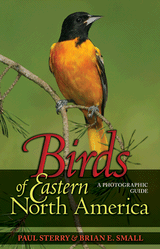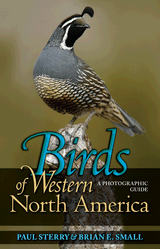In the arena of North American avian field guides, illustrated guides have reigned supreme. However, if one could imagine an arms race between illustrated guides and photographed ones, it is safe to say that the latter have taken huge strides in recent years in closing the gap. Sure, everyone loves The Sibley Guide to Birds but then again, The Shorebird Guide is pretty sensational too. The Smithsonian Guide to the Birds of North America released in 2008 made a strong case for the utility and aesthetic potency of a photographic reference guide. The new Photographic Guides by Paul Sterry and Brian E. Small are equally persuasive regarding field guides!


Princeton University Press has published a fine pair of guides for North America: Birds of Eastern North America: A Photographic Guide and Birds of Western North America: A Photographic Guide. Paul Sterry, widely-known and respected author, crafted the text while Brian Small, the primary photographic contributor for a number of other popular guides, delivers delightful digital photos. The range maps are the product of the Cornell Lab of Ornithology. With so august a pedigree, can these Photographic Guides live up to the standard of a top-notch illustrated field guide?
I think they do.
For me, the first consideration for a field guide is always how well the birds are depicted. Small’s photos are big, bright, and tack-sharp. Many of them equal or exceed the best photos I’ve seen of their subjects. As a result, readers will feel comfortable making identifications based on these images, which isn’t always the case with photo field guides. In fact, I’d probably feel better using this guide’s stunning photo of a Warbling Vireo against a bird in the field than I would any of the illustrations I’ve seen.
On the other hand, many of the birds are allocated only one photo each, which seems insufficient for certain calls. For example, the photos of Veery and Swainson’s Thrush don’t adequately highlight the differences between these two superficially similar thrushes. However, instances like these are minor in the face of the evident artistry of these guides.
A picture may be worth a thousand words, but that didn’t prevent the authors from providing abundant text to describe each species. Sterry’s generous accounts supplement the accompanying photographs well, which changes the calculus of words and pictures considerably.
The Photographic Guides seem a bit larger than my old National Audubon photo field guides. Nonetheless, they’re still portable enough for field use. Furthermore, those large, lovely full-color photographs make their use in the field a lot more likely!
Birds of Eastern North America: A Photographic Guide and Birds of Western North America: A Photographic Guide both seem like worthwhile acquisitions for field guide consumers and completists alike. I may not be ready to leave my favorite illustrated field guide behind next time I visit unfamiliar territory but I’ll be packing the relevant Photographic Guide along with it!













I just wrote my own review of the western version of this photographic guide yesterday and scheduled the post for tomorrow.
This bird guide is stunningly beautiful! The layout is very modern and exciting with the color use, the top corner tabs, and the pictures that merge into one another. It is really fun to look at! I think this guide will excite more kids about birds than any previous field guide.
It is about the right size for a field guide, but because the cover is simply cardstock rather than vinyl, it will not withstand the elements like my Sibley’s or Peterson’s will. When I’m out birding with my kids, doing a driving tour, I’ll let them use this new guide in the car as it will certainly keep their interest more than artistic renderings of traditional field guides.
If you would like to see the photos of the warbling vireo Mike mentions, please visit the Princeton University Press blog: http://press.princeton.edu/blog/2009/12/08/10000-birds-reviews-birds-of-easternwestern-north-america/
Very helpful review, Mike, thank you!
Indulge me in one ‘pet peeve’, though: Nearly all field guides have illustrations. In some, those illustrations are paintings, in others they are photographs. A guide without illustrations would be Pete Dunne’s http://birdaz.com/blog/2006/06/11/pete-dunnes-essential-field-guide-companion/ though even there one might argue that the vividness of some of the language is tantamount to illustration.
Sorry, just had to get it off my chest! 🙂
r
Robert, thanks for adding your observations. You’re right about the cover material; a guide with this physical profile could definitely benefit from a tougher, water-resistant cover.
Jessica, thanks for posting Brian’s warbling vireo photos. They really are amazing!
Rick, thanks but, while I am always impressed by your etymological exactitude, I feel compelled to draw the semantic line here! While “illustration” does technically encompass photographic representations, the word also bears a strong connotation of artistic rendering rather than photographic capture. Plus, the traditional dichotomy in the realm of field guides is typically phrased as one between illustrations vs. photographs. How else can we simply and elegantly describe this major distinction?
Won’t argue, but I will continue to cringe!
🙂
Have a great evening,
rick
We just got these in the Seattle Audubon Nature Shop where I work, about 3 weeks ago. Although I’ll still reach for my Sibley or Nat Geo for tricky ids – this is a great book for reference. The photos are practically perfect, worlds better than other guides in my opinion. My bookshelf may not have room for another NA bird id book, but I keep pointing it out to folks who want photos.
Nice review!
I was walking in Jacobsburg state park in PA and saw a bird that I’ve never seen before. I’m not an avid bird watcher, but I can name most of the common birds. This one was pure white of body, about 6 feet in length, white wings with black along the shoulder to the tip, and a bright red strip of feathers on the top of it’s head. What could it be?! I didn’t get a picture of it, as it was flying over the water pretty fast. It had a long beak also. Please email me if you know what it is! lottanoyes123@yahoo.com
Thanks,
Marie